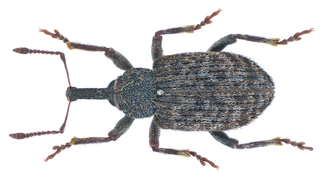
The wormwood pug is a moth of the family Geometridae. The species was first described by Carl Alexander Clerck in 1759. It is a common species across the Palearctic region as well as North America.

The mottled umber is a moth of the family Geometridae. It is common throughout much of the Palearctic region. The species was first described by Carl Alexander Clerck in 1759.

Procas granulicollis is a beetle in the family Curculionidae, the true weevils. It was first described in 1848 from a specimen collected in Cumbria and has since been found at a number of other sites in Britain, mainly in the west. It was thought to be endemic to the island but is now also known to occur in Spain.

Papilio caiguanabus, the Poey's black swallowtail, is a species of Neotropical butterfly in the family Papilionidae. It is endemic to Cuba.

Morpho aurora, the Aurora morpho, is a Neotropical butterfly found in Bolivia and Peru.

Morpho richardus, or Richard's morpho, is a Neotropical butterfly found only in Minas Gerais, Brazil.

Ecliptopera silaceata, the small phoenix, is a moth of the family Geometridae. The species was first described by Michael Denis and Ignaz Schiffermüller in 1775.

Scopula imitaria, the small blood-vein, is a moth of the family Geometridae. It was first described by Jacob Hübner in 1799 and it is found throughout Europe and in North Africa.
Cabirus is a genus of skippers in the family Hesperiidae. It is monotypic, being represented by the single species Cabirus procas.

Agriopis aurantiaria, the scarce umber, is a moth of the family Geometridae. It was first described by Jacob Hübner in 1799 and it is found throughout Europe from Spain through Central Europe to Russia. In the south it can be found from the western Mediterranean to the Black Sea and the Caucasus. Its northern distribution reaches as far as central Fennoscandia. The species can be found in many different places, including deciduous forests, orchards, gardens as well as parks and settlement areas.

Alexandru Proca was a Romanian physicist who studied and worked in France. He developed the vector meson theory of nuclear forces and the relativistic quantum field equations that bear his name for the massive, vector spin-1 mesons.

Papilio bachus is a butterfly of the family Papilionidae. It is found in South America, including Colombia, Ecuador, Peru, and Bolivia.

Acraea petraea, the blood acraea or blood-red acraea, is a butterfly of the family Nymphalidae. It is found in coastal forests from KwaZulu-Natal to Mozambique, Kenya and Malawi.

Carsia sororiata, the Manchester treble-bar, is a moth of the family Geometridae. The species was first described by Jacob Hübner in 1813. It is found in northern and central Europe, the Urals, Siberia, the Far East, northern Mongolia and in North America from Alaska to Newfoundland and to New Hampshire.

Graphium antheus, the large or larger striped swordtail, is a species of butterfly in the family Papilionidae (swallowtails), found in tropical and sub-Saharan Africa.

Battus belus, the Belus swallowtail is a species of butterfly from the family Papilionidae that is found in Brazil, Colombia, Guatemala, Peru and Venezuela.

Zygaena brizae is a species of moth in the Zygaenidae family. It is found in France, Italy, Austria, the Czech Republic, Poland, Slovakia, Hungary, the Balkan Peninsula, Moldova, Ukraine, Russia and Georgia.

Zygaena punctum is a species of moth in the family Zygaenidae. It is found in Poland, the Czech Republic, Slovakia, Austria, Slovenia, Italy, the Balkan Peninsula, Moldova, Ukraine, Russia and Turkey.

Acraea leucopyga is a butterfly in the family Nymphalidae. It is found in Zambia, Malawi, the Democratic Republic of the Congo (Shaba), Tanzania and Uganda.

Acraea sotikensis, the Sotik acraea, is a butterfly in the family Nymphalidae which is native to the African tropics and subtropics.




















